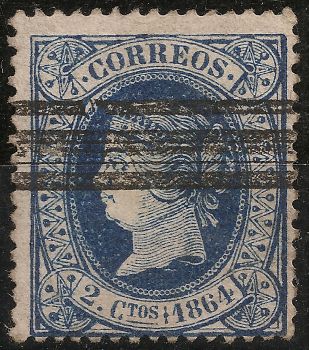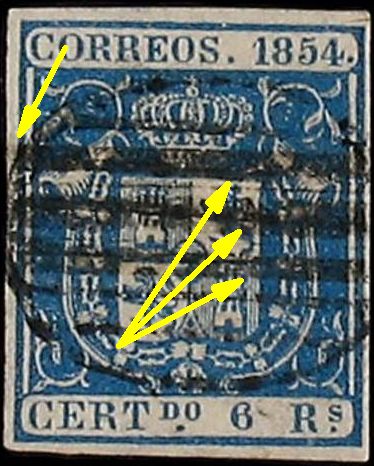Post by spain1850 on Jul 24, 2013 6:29:51 GMT
This is one subject I see a lot of inquiries about on boards and forums I've visited, so I think I'll just get a thread going now.
Starting with the issues of 1854 and extending through the issues of 1882, all unsold quantities of Spain's stamps, including those that remained at the printer, were suppose to receive a 3-bar rolled cancel (as pictured below). These 3-bar cancelled remainders were then sold outright to stamp dealers at a fraction of the face value. However, like most things in the world, it didn't always go as planned. There are some issues that are actually harder to find with a remainder cancel than in unused form, which tells me that not all the unused stamps got returned.
There are also a few unissued stamps where the entire printed run (at least that was how it was suppose to be) was "remaindered" and the only way you can buy them is with a 3-bar cancel, such is the case of the 2 cuartos stamp below.

These bar cancelled remainders are not hard to find at all. Most oldtime, general collections have a few in them. Although they are not very nice to look at on your album pages, they do offer the collector an affordable alternative to buying a postally used copy of many issues. Afterall, they are in fact genuine stamps, and with so many forgeries having been made of early Spanish stamps, this is one way to own a genuine stamp without having to get it certified. And since these are, for the most part, genuine stamps, although unsightly, they can be used as reference copies to weed out forgeries if you are in the market to upgrade to postally used. Most of the early Spanish stamps have "secret marks", which can be seen on the remainders.
One thing that does need mentioning however is the practice of fakery with regards to these 3-bar cancels. Since they are usually far cheaper to buy than postally used copies, it has been very tempting to some to try their hands at faking a postally used cancel.

This is a 6r from the 1854 set. Someone attempted to disguise the 3-bar cancel by placing an oval grill cancel over it. Evidence of the thicker, 3-bar cancel can be seen where the 3 yellow arrows are pointing. You can also see a bit of the roller cancel extending past the oval (arrow on left). The normal oval grill cancel has much thinner bars and cannot hide the thick 3-bar roller cancel entirely. I have seen quite a few of these, mostly with the 6 Real as shown.
Starting with the issues of 1854 and extending through the issues of 1882, all unsold quantities of Spain's stamps, including those that remained at the printer, were suppose to receive a 3-bar rolled cancel (as pictured below). These 3-bar cancelled remainders were then sold outright to stamp dealers at a fraction of the face value. However, like most things in the world, it didn't always go as planned. There are some issues that are actually harder to find with a remainder cancel than in unused form, which tells me that not all the unused stamps got returned.
There are also a few unissued stamps where the entire printed run (at least that was how it was suppose to be) was "remaindered" and the only way you can buy them is with a 3-bar cancel, such is the case of the 2 cuartos stamp below.

These bar cancelled remainders are not hard to find at all. Most oldtime, general collections have a few in them. Although they are not very nice to look at on your album pages, they do offer the collector an affordable alternative to buying a postally used copy of many issues. Afterall, they are in fact genuine stamps, and with so many forgeries having been made of early Spanish stamps, this is one way to own a genuine stamp without having to get it certified. And since these are, for the most part, genuine stamps, although unsightly, they can be used as reference copies to weed out forgeries if you are in the market to upgrade to postally used. Most of the early Spanish stamps have "secret marks", which can be seen on the remainders.
One thing that does need mentioning however is the practice of fakery with regards to these 3-bar cancels. Since they are usually far cheaper to buy than postally used copies, it has been very tempting to some to try their hands at faking a postally used cancel.

This is a 6r from the 1854 set. Someone attempted to disguise the 3-bar cancel by placing an oval grill cancel over it. Evidence of the thicker, 3-bar cancel can be seen where the 3 yellow arrows are pointing. You can also see a bit of the roller cancel extending past the oval (arrow on left). The normal oval grill cancel has much thinner bars and cannot hide the thick 3-bar roller cancel entirely. I have seen quite a few of these, mostly with the 6 Real as shown.


